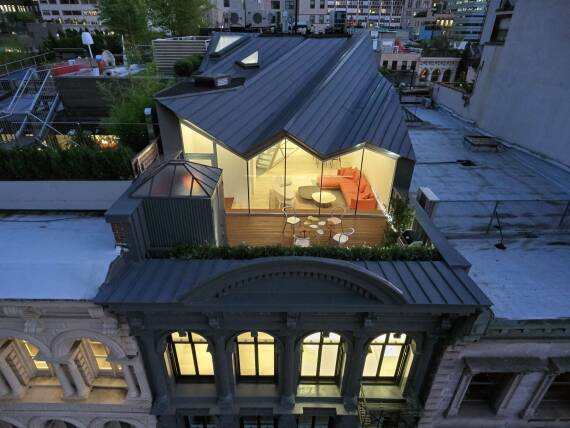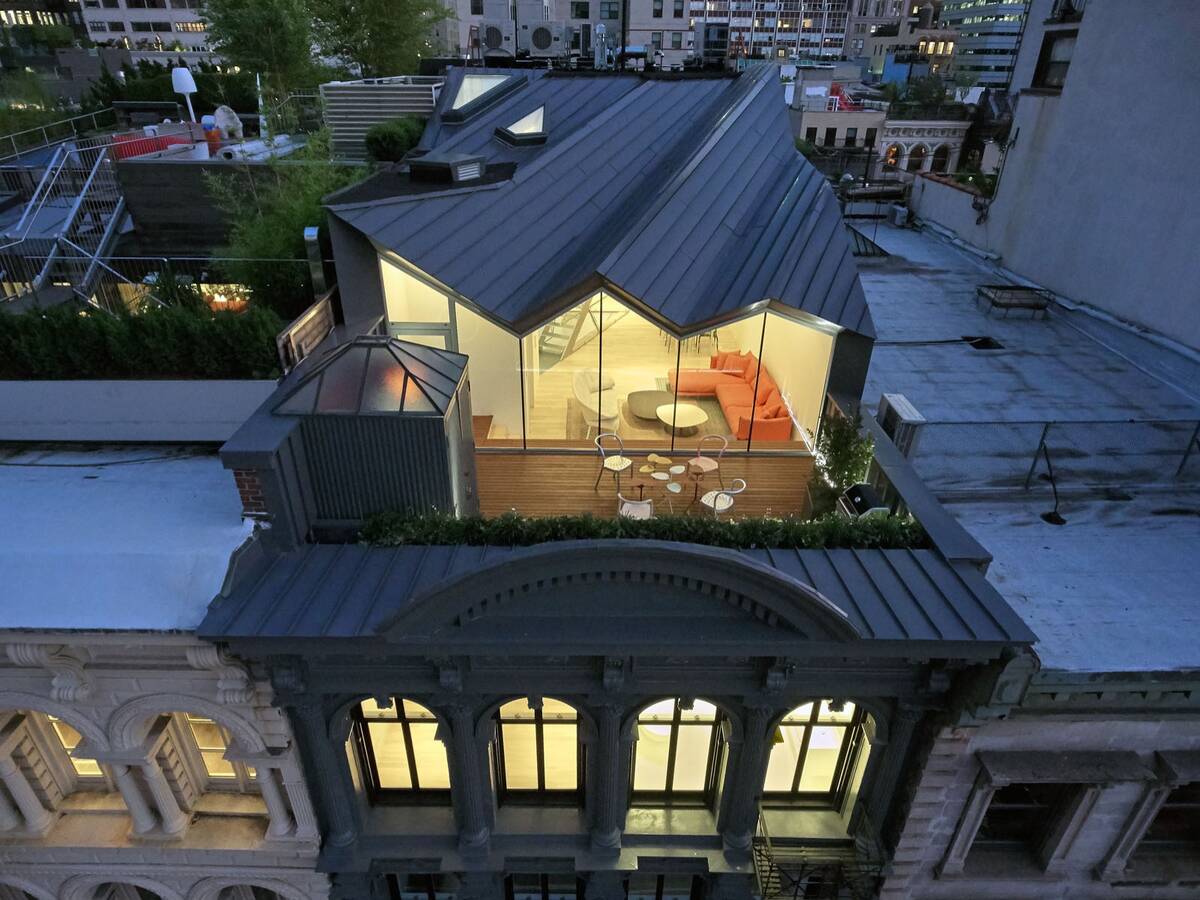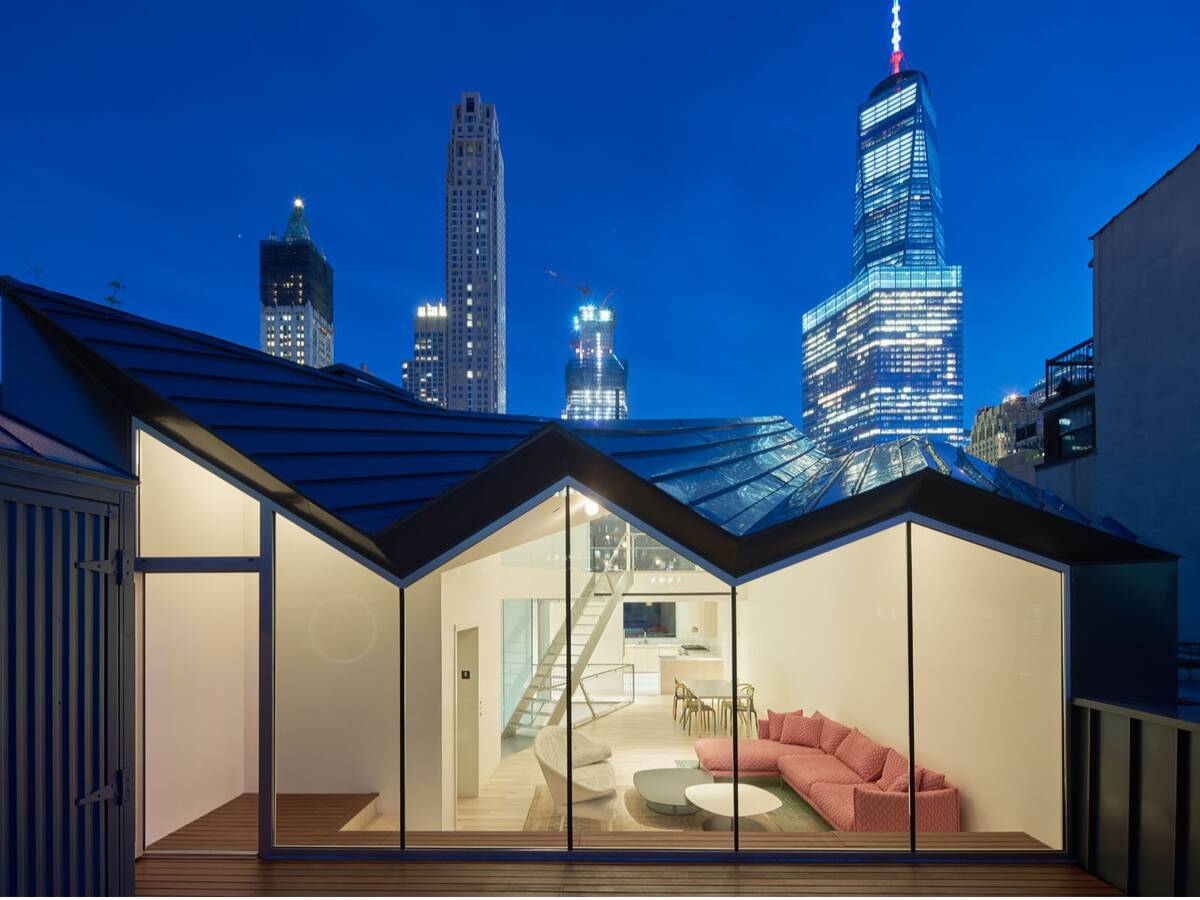
The AXOR interview
Amale Andraos and Dan Wood: Stealth Building
Amale Andraos and Dan Wood, founders of influential New York architecture firm WORKac, have gained international recognition for projects that reinvent the relationship between urban and natural environments. Among those projects is the outstanding Stealth Building in downtown Manhattan, ArchDaily’s Building of Year in 2017. The architects speak with AXOR about their approach to the Stealth Building, which typifies Compact Luxury principles.
Reimagining the metropolis
AXOR: From your viewpoint as architects, what is the future of urban living?
Amale Andraos: In the last couple of decades, there has been a sense that urban living is where everybody ends up. Now, with COVID, obviously there’s a re-questioning of that, but for us, I think it points to the excitement of reinventing urban living.
Dan Wood: In our work, we’re always pushing this idea of, What can we bring from nature or the wild or rural life, into the city? For us, it was an interesting thought experiment, and then it became an interesting practice that we were engaged in, but it always had this sense of being an extra thing. Whereas now, this pandemic is going to have such a major impact. A lot of people wanted to get out and to escape back to the suburbs, which I think is not a great trend. We’re going to have to find ways to provide amenities of rural living, or suburban living, in the urban center.
AA: Yeah, more outdoor space, more space for leisure, so that it’s not just about work and commerce, right? It’s about experience. Because of this moment of isolation, I can imagine people wanting to be more together, again.
DW: I could imagine live-work changes, too, where people are still working from home, but maybe colleagues come over, and you have a meeting in your house. We see the advantages to working from home, but we don’t want to be alone all the time.
Evolving needs and desires
AXOR: What have you learned from your urban clients about their evolving needs?
AA: The clients we’ve worked with in the city have wanted to bring all these things together, so even in the smallest space there’s a lot of thinking about a social aspect connecting inside and out. We did quite a bit of that in the Stealth Building, even at the small scale of showers with small greenhouses on top and kitchens with herb gardens, or making moves to cut out space to be more connected to the outdoors.
AXOR: What does luxury mean in the context of urban living?
AA: Luxury is a really good word to reinvent. There’s such a tradition of that. Modernism reinvented luxury as pure function. I think that luxury for us is sustainability—thinking about the relationship of the built environment to climate change at all scales. It’s a very urban idea—designing in a sustainable way that isn’t just about technology but about questions of density.
Interior and exterior narratives
AXOR: What can architects do not just to optimize space in urban homes, but to enhance it? To give it meaning or character, or even soul?
DW: What we’ve found is that outdoor space is always positive. We also found that ‘outdoors’ can exist in many different iterations. In the Stealth Building, we simply integrated grow lights, and the fern gardens have very little access to actual outdoor space, yet they’re extremely lush. Just a tiny bit of irrigation goes a really long way.
AA: And the other thing was to think about—you mentioned meaning—is narrative, materials, experiences, and always to think about an interior as one would about the city—in terms of the richness of experience, creating a wide range of spatial, material experiences, and having ideas for scenarios for what might happen in an interior.

Updating historic buildings
AXOR: Why do you take on a project like the Stealth Building? What’s the challenge or the inspiration for you in taking on a project like that?
AA: For us, again, reinventing urban living in a sustainable way means considering the question of adaptive use, and bringing new life to old buildings that are gorgeous, and the challenge of how you add more living spaces. How do you add a penthouse but not have it visible from the street?
Embracing challenges
AXOR: What particular challenges did the Stealth Building present?
AA: The challenge of landmarks is well known. In the end it went really well, so it was a productive challenge. As Dan said, it’s difficult to think in the abstract, where we don’t know who is going to live in these spaces. I think we tried to imagine ways of living that are not so personal, but also not generic. We didn’t have width, and light was limited, but we had height. We combined the fact that we had to jam a lot of stuff into the middle of the apartment with the quality of having extra height to create a kind of landscape. Another challenge was to create a three-story penthouse that remained entirely invisible from the street.Stealth Building and Compact Luxury
AXOR: How does the Stealth Building express Compact Luxury principles?
DW: Compact Luxury is adding more when you have less. What we’ve tried to do is actually get more by compacting. That’s what happened with the Stealth Building. How do we bring, even into the simplex [a ‘third space’ in between living and sleeping areas, with grow lights and fern garden], this sense of urban dense living with a variety of experiences? Even though it’s only a meter tall, we realized we could get a lot of world up there.
AA: It’s using the extra height to create a difference, so really carving out these moments where something surprising happens that is different. We do more with less if we are denser, if we use space in the section to increase the different experiences of living. That’s luxury. But doing it in a compact way as opposed to a sprawling footprint, that’s sustainable spatially through design, not just technology.
Simple luxuries in the bathroom
AXOR: How about Compact Luxury in the bathrooms?
AA: When one thinks about luxury in the bathroom, it might be about an outdoor shower or natural light, having a window. But when you take those ideas and reinvent them in a much denser urban space like New York, where everything is compacted, luxury becomes a mosaic tile pattern of trees on the wall to give the sense of forest, or it’s a grow light supporting a fern garden in the shower. So you walk into the bathroom and have a special experience. So, to bring those ideas of luxury that one has to everyday urban living. The bathroom is very much at the heart of that.
AXOR: How did the choice of AXOR contribute to the overall effect or experience you were trying to convey?
DW: Well, we just tried to think of the most beautiful fixtures. I mean, it’s a small moment that you intersect with a detail that’s part of everyday life, which is not true for most architectural details. And when the fixture is well designed…
AA: …You can feel it. It’s the one thing that gets so much use. It needs to function perfectly. It needs to be durable, and it needs to feel really beautiful without overdoing it. And I think the AXOR fixtures do that. They’re not design-y, just the right amount that it feels special, that it’s not overdone.Personal ideas of luxury
AXOR: What is luxury for you? How do you define it on your own terms?
DW: Time is luxury for us, unfortunately.
AA: Time allows you to go to the farmers market instead of getting a delivery. It allows you to think about where the food comes from or how you want to live. We’re trying to bring those ideas to our everyday life as well—rethinking the relationship between work and life, and the boundaries. It’s a very important moment where people are reconsidering how they occupy the planet and their sense of responsibility.
The influence of the city
AXOR: How does living in the city influence your work?
AA: I think the idea of this city is still an idea of cosmopolitanism, people coming from different places and backgrounds—certainly, New York still has that. And just the interaction and this sense of diversity—that is still what’s very attractive to us in terms of this feeling of being brought into projects where things come together even if they’re not meant to be together, but just putting them together and having a sense of the vibrancy of those encounters. And I think living in the city, thinking about cities influences our work at every scale. When we design an apartment, we’re thinking about urban planning somehow.Trusted partners


